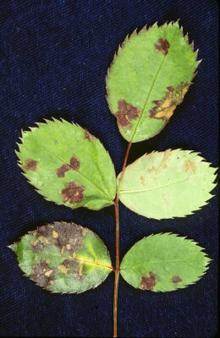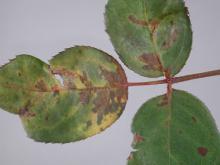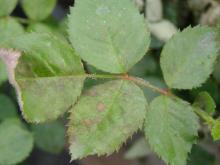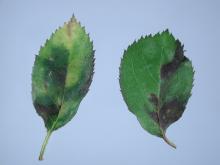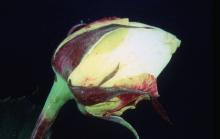See:
Blackberry (Rubus spp.) - Downy Mildew
Cause Peronospora sparsa, a fungus-like organism that may be systemic in roses. It overwinters as mycelium in stems, root crowns and roots or as oospores in leaf debris and stems. Humidity above 85% and temperatures of 60°F to 70°F favor the disease. Sporulation does not occur below 40°F or above 95°F. Infection occurs on young plant parts either through stomata or directly through the cuticle within 8 to 12 hours. Infection usually does not occur on mature leaves. Within a week infected tissues are extensively colonized. Sporulation may occur through the stomata of leaves or directly from stems or flowers. Sporangia may be water splashed or blown by air currents to healthy foliage. Cuttings taken from infected stock plants will carry the disease and may not root well. Infected stock may or may not show symptoms. Excess nitrogen favors disease development.
Cross inoculations with isolates from either rose or Rubus sp. (such as blackberry) show they can infect the other host.
Symptoms Purplish-red to dark-brown, irregular spots on leaves. Leaflets may yellow but contain "green island" areas. Major leaf veins often restrict fungal growth such that lesions become angular as they enlarge. A grayish spore mass may be on the leaf underside if humidity persists. However, the diagnostic sporulation of this fungus is not abundant. Defoliation also may occur in extreme cases. Small spots or long purplish areas may form on canes and may kill twigs. Infection of young canes may result in dieback and longitudinal cracking, while older canes may fail to reach minimum production size. Purple patches may form on floral sepals. Some people may confuse this with black spot or even rust. In the early stages, it may get confused with nutrient deficiency or spray injury.
Cultural control Sanitation and low humidity are key factors.
- Lower humidity in the greenhouse by raising temperatures and venting at key times of day.
- Space plants for better air flow and reduced humidity.
- Rake leaves and prune out old flowers and stems. Burn or bury them or send them to a landfill.
- Take cuttings from plants with no history of the disease.
- Scout plants carefully for symptoms of the disease especially the undersides of leaves and any stock plants or plants held over from the previous year.
- Remove and destroy any tissue with symptoms of the disease. Entire leaves should be removed even if one leaflet has symptoms.
- Isolate new plants and observe for symptoms prior to integrating into your plantings.
- Although hot water soaks have been effective they have also damaged cuttings. Hot water soaks are not recommended until time and temperature durations have been investigated.
- Maintain adequate, not excessive, fertility. Silicon applications have been found to help strengthen tissue and minimize tissue damage in Columbia.
- Raising greenhouse temperatures above 85F for 3 days has been helpful to maintain clean stock in mini pot roses.
- Use drip irrigation and avoid overhead applications or apply such that plants are not wet for extended periods of time.
- Sunny sites and space between plants will be helpful in the landscape.
Chemical control Focus on cultural control methods first. Do not use mefenoxam-based products (Group 4 fungicides) alone; may not offer much control, and encourage resistance to develop. Chemical control tactics help prevent infection but may not be helpful once the disease starts. Good spray coverage of all plant surfaces including the underside of leaves is essential. Alternate or tank-mix products from different groups that have different modes of action. Limit the use of any one group during crop production.
Products available in home packaging:
- Bonide Copper Fungicide at 8 oz/3 gal water. Group M1 fungicide. H
- Monterey Garden Phos at 2 to 4 teaspoons/gal water as a foliar spray. Can be used in landscape sites. Group P7 fungicide. H
Products available for commercial use. Alternate or tank-mix products from different groups that have different modes of action. Limit the use of any one group during crop production.
- Adorn at 2 to 4 fl oz/100 gal water plus another fungicide. Daconil was found to be a good mixing partner in North Carolina. 12-hr reentry.
- Aliette at 2.5 lb/100 gal water. Do not use within 14 days of copper spray. Do not use with adjuvants. Rated very good to excellent. Group P7 fungicide. 24-hr reentry.
- Areca at 2.5 lb/100 gal water as a foliar application. Group P7 fungicide. 12-hr reentry.
- Compass 50 WDG at 1 to 2 oz/100 gal water. Do not use organosilicate additives. Rated from some control to excellent. Group 11 fungicide. 12-hr reentry.
- Daconil Weather Stik at 1 pint/100 gal water. "Knock Out" and "Double Delight" roses can be sensitive resulting in damaged foliage. Rated very good. Group M5 fungicide. 12-hr reentry.
- Disarm 480 SC at 1 to 4 fl oz/100 gal water. Group 11 fungicide. 12-hr reentry.
- Fenstop at 14 fl oz/100 gal water. For greenhouse use only. Group 11 fungicide. 12-hr reentry.
- Fosphite at 1 to 2 quarts/100 gal water. Do not use copper products within 20 days of treatment and do not use spray adjuvants. Group P7 fungicide. 4-hr reentry.
- Heritage at 2 to 4 oz/100 gal water plus a non-silicone-based wetter sticker. Heritage can also be used at 1.6 to 8 oz/A for commercial rose production. Rated from none to very good. Group 11 fungicide. 4-hr reentry.
- Insignia SC at 3 to 6 fl oz/100 gal water. Do not use with organosilicate-based adjuvants. Use preventively only. Group 11 fungicide. 12-hr reentry.
- Kocide 2000-O at 0.75 to 2 lb/A. Discoloration of foliage or blooms has occurred on some cultivars. Group M1 fungicide. 48-hr reentry.
- Mefenoxam 2 AQ at 0.49 to 0.98 fl oz/100 gal water plus another fungicide with a different mode of action. Rated very good to excellent. Group 4 fungicide. 48-hr reentry.
- Micora at 4 to 8 fl oz/100 gal water. Rated very good. Group 40 fungicide. 4-hr reentry.
- Mural at 7 oz/100 gal water. Rated very good. Group 7 + 11 fungicide. 12-hr reentry.
- Nu-Cop 50 DF at 1 lb/100 gal water. Group M1 fungicide. 24-hr for greenhouse, 48-hr reentry for all other.
- Orvego at 11 to 14 fl oz/100 gal water. Group 40 and 45 fungicide. Has variable effectiveness with rating from some to excellent. 12-hr reentry.
- OxiPhos at 1.3 to 4 quarts/100 gal water as a foliar spray. Group P7 fungicide. 4-hr reentry.
- Pageant at 6 to 12 oz/100 gal water. Do not use with organosilicone-based adjuvants. Rated very good. Group 7 + 11 fungicide. 12-hr reentry.
- Segovis at 0.6 to 3.2 fl oz/100 gal water plus another fungicide. Maximum of 2.4 fl oz/A. Group 49 fungicide. 4-hr reentry.
- Segway SC at 2.1 to 3.5 fl oz/100 gal water. Rated good to excellent. Group 21 fungicide. 12-hr reentry.
- Stature SC at 6.12 to 12.25 fl oz/100 gal water. Rated very good to excellent. Group 40 fungicide. 12-hr reentry.
- Subdue MAXX at 1 to 2 fl oz/100 gal water plus another fungicide with a different mode of action. Rated very good to excellent. Group 4 fungicide. 48-hr reentry.
- Zonix at 45 to 76 fl oz/100 gal water. Can be sprayed on crop or injected into irrigation system. Short residual so may have to be used frequently for adequate results. 4-hr reentry.
References Salgado-Salazar, C., Shiskoff, N., Daughtrey, M., Palmer, C.L., and Crouch, J.A. 2018. Downy mildew: a serious disease threat to rose health worldwide. Plant Disease 102:1873-1882.


